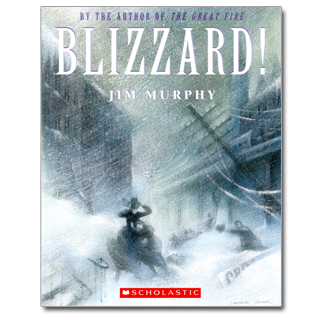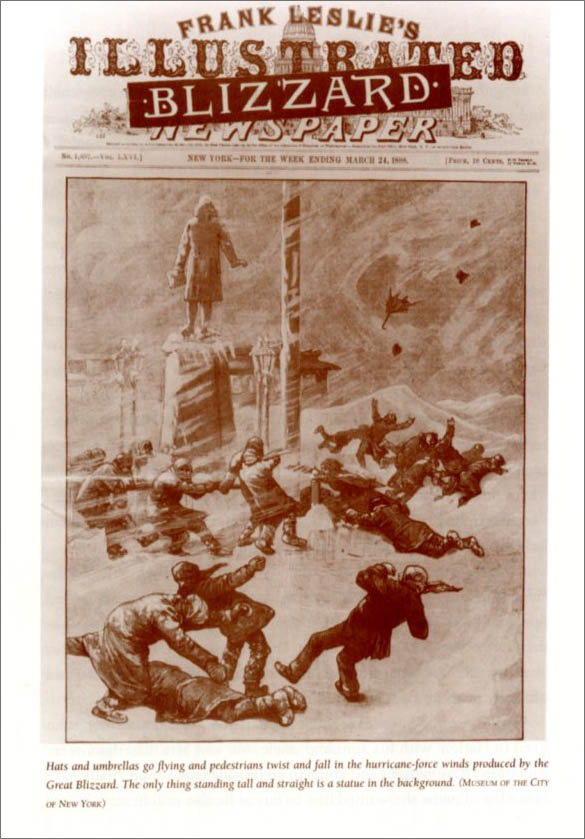
A FEW OTHER EVENTS FOR
MARCH 11:
- Happy birthday D. J. Chaconas (A Hat for Lilly), Avner Katz (The Little Pickpocket), Jonathan London (Froggy series), Peter SĂs (The Wall: Growing Up Behind the Iron Curtain), and Libba Bray (Going Bovine) .
- It’s the birth date of Wanda Gag (1893–1946), Millions of Cats, and Ezra Jack Keats (1916–1983), The Snowy Day.
- In 1824 the United States War Department creates the Bureau of Indian Affairs. Read The Absolutely True Diary of a Part-Time Indian by Sherman Alexie, illustrated by Ellen Forney.
- It’s Johnny Appleseed Day. Read Johnny Appleseed Steven Kellogg, Johnny Appleseed by Reeve Lindbergh, illustrated by Kathy Jakobsen Hallquist, and Johnny Appleseed by David L. Harrison, illustrated by Mike Wohnoutka.
On March 11, 1888, a record blizzard hit the East Coast. Although parts of the country have seen record snow falls this year, most areas have snow-removal equipment and constant weather monitoring to lessen the impact of Mother Nature. But such was not always the case, as Jim Murphy relates in his compelling story about the 1888 snowstorm, Blizzard!
Drawing on primary sources, newspapers, and accounts written by survivors, Murphy begins the saga on March 10, 1888, a day warmer than normal on the East Coast. The Army Signal Corp, then the weather monitoring unit of the United States government, closed its offices at midnight, to observe the Sabbath. On Sunday, March 11, two air masses began to collide—one moving over the northern part of the country and one swinging up the East Coast from the south. They created one doozy of a snowstorm. In this era of snow removal by shovel, no underground transportation, and no underground electricity or wires, the massive storm wreaked a kind of damage unimaginable today.
Trains came to a halt and passengers had to try to walk to safety or die in the storm. Wires came down over the city of New York and electrocuted people. Even farmers heading from their houses to their barns died of hypothermia and exhaustion. Focusing the narrative on the struggles of those braving the elements, Jim Murphy walks readers through the dangers posed by massive snow. Some died trying to get to work the next Monday. Others died, like Senator Conklin, who suffered a heart attack brought on by battling the elements. Even to walk a few blocks in New York City put people in harm’s way. Without modern snow-removal equipment, day laborers, mostly Italians, were solicited to clean the streets. But no municipal government was set up to handle a disaster of this magnitude.
As I reread Blizzard! a winter storm piled two-foot snow drifts around my house. Jim Murphy made the disaster of 1888 seem so real that I kept checking for death reports on the Internet. In Blizzard! readers not only see the elements, they taste and feel the fury of the snow. And they get to know the people affected by the storm.
In this book, ideal for third through seventh grades, Jim Murphy brings to life the snowstorm that changed America, giving us the United States Weather Bureau and city governments ready to respond to disaster. Many classes use the book in a snow unit this time of year. Otherwise it makes compelling reading in a warm house by a fire. No one describes disasters—fire, snowstorms, or the plague—to children better than Jim Murphy.
Here’s a page from Blizzard!:
A thick buildup of ice made the streetcar jump the tracks several times, while slippery rails forced the elevated train to crawl along. The worst part of the Alegos’ journey was the two-block walk from the station on 86th Street to their front door. A vicious wind-driven sleet slashed at their faces, numbed their fingers, and caused them to slip and slide all over the icy sidewalk. The trip to the Bronx had taken one hour; the return journey was a hard four-hour trek. When they stumbled inside at midnight, James remembered that a fine snow had just begun to fall.Â
Â
Originally posted March 11, 2011. Updated for .














Jim Murphy is an absolutely fantastic children’s/YA nonfiction author. He won the Margaret Edwards lifetime achievement award in 2010 for significant contribution to YA lit and was the FIRST nonfiction writer to receive this award.
Even read in the middle of the summer, Blizzard is chilling. Read in the winter, it freezes you to your chair as you follow the great snowstorm of 1888. You see people young and old, rich and poor, who struggled to survive the blizzard that came without warning.
Murphy’s work stands out to me as authentic and realistic, as he includes newspaper articles and photographs. He tells stories about disasters, but he also tells about the people who lived through them – or didn’t.
I’d never heard of this book until I saw it in my 9th grader’s backpack this morning! He is reading it for English class. Funny it’s the one reviewed today! I’m going to read it over the weekend.
A few months after reading this book, I experienced my first Boston winter. On a day where there was almost 20 inches of snow, I walked to the T and was amazed to see the train still running. It’s a harrowing story to read, but it is more amazing when you see the results of such a blizzard in real life!
I think this is one of those times when the children’s book triumphs – I recently read an adult book on this same topic (because I had liked this Murphy text so much) and Murphy has clearly written the superior story.The information was so well organized and created such a strong narrative voice. Though I knew that his writings are always historical authentic, the people within the book still managed to come alive for me in a way that the adult book simply did not.
I think it is that opening anecdote of his own experience with heavy snow that sets the tone of the book so well – Murphy’s personal investment shines through, even though I can see the care and attention he has devoted to keeping the book factual. To me, this book is proof that nonfiction does not mean emotionless and dry.
While I love all of Jim Murphy’s meticulous researched writings, this one gets my vote as his very best.
I read this book for Susan Bloom’s Nonfiction class at Simmons. I loved that class because it was the perfect combination of my History degree and my (almost) degree in Children’s Lit. This was one of my favorites, and I ended up purchasing it. Susan asked us all if a particular image stuck out to us as we read it, and one of mine was the red feather from the hat.
Ah, Blizzard. I adored this book. It was the first book I read as a grad student in the Simmons children’s literature program, so I remember it well.
When I was little, I wanted to read fantasy and fiction. I never liked nonfiction much because I thought the narrative was too stale. However, I learned a lot from Murphy’s book AND I couldn’t put it down because of his compelling narrative. Murphy helped me realize that nonfiction books can be JUST as interesting and engaging as a fiction book. I was also a big fan of how Murphy characterized the blizzard.
The storm itself is something of a ruthless character. A villain, really. I recall one scene where the storm churned up the waves, causing the sea to toss the boats around as if they were bath toys. It was really awful. Murphy did a great job in showing the magnitude/severity of this storm.